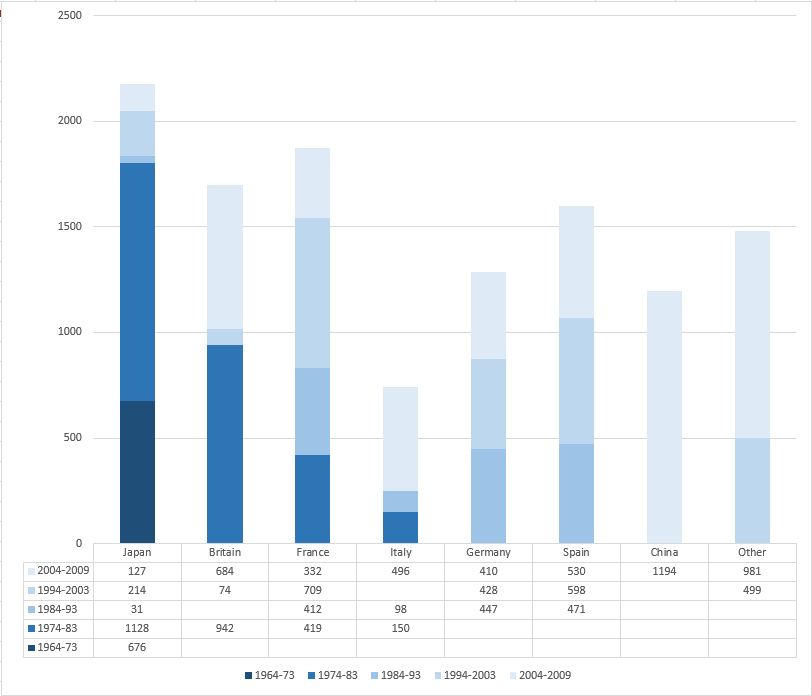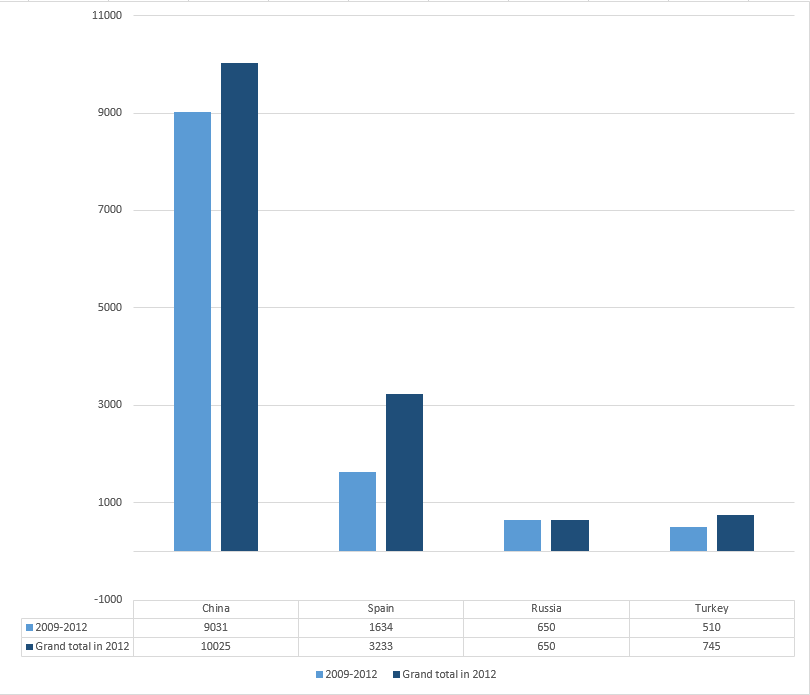Timeline of high-speed rail
From Timelines
This is a timeline of high-speed rail, focusing on speed evolution of the transport.
Contents
Big picture
| Time period | Development summary |
|---|---|
| 19th century | Railways originate in Europe during the Industrial Revolution. Since the very beginning, the speed of passengers trains is an essential argument to compete, not necessarily with other transport modes but among the different companies. The speed on rails also constitute an evidence of technological development of the most advanced countries at that time.[1] |
| 1930s | Trains designed for commercial operation between cities average 133 km/h.[2] |
| 1950s | Japanese railway engineers begin their own extensive research and development on high speed rail, aiming to improve rail transportation for the densely populated and rapidly growing Tokyo–Osaka corridor. In France, tests conducted by the French National Railway show that speeds over 300 km/h could be achieved with powerful electric locomotives.[3] |
| 1964 < | The Japanese Shinkansen becomes the first high speed system in the world, marking a new era of modern transport. Japan is the first country in the world to build a dedicated line for new high speed trains.[4] |
Visual data
Full timeline
| Year | Event type | Details | Present day country/location |
|---|---|---|---|
| 1812 | English manufacturer Matthew Murray builds the first commercially viable steam locomotive.[2] | United Kingdom | |
| 1829 | Speed | English engineer George Stephenson develops his “Rocket” locomotive, which reaches 50 km/h, representing a true high speed consideration for railways at the time.[1][2] | United Kingdom |
| 1845 | The British Great Western Railway introduces the fastest rail service in the world with its London to Exeter expresses, which averages 70kph.[5] | United Kingdom | |
| 1854 | Speed | Railways reach 130 km/h.[1] | |
| 1891 | Engineer Károly Zipernowsky proposes a high-speed line Vienna–Budapest, bound for electric railcars at 250km/h. | Austria, Hungary | |
| 1893 | Dr. Wellington Adams proposes an air-line from Chicago to Saint Louis of 406 km At a speed of 160 km/h. | United States | |
| 1899 | The Prussian state railway joins with ten electrical and engineering firms and electrified 72km of military owned railway between Marienfelde and Zossen in actual Germany. The line used three-phase current at 10 kilovolts and 45 Hz. | Germany | |
| 1903 (October) | The Siemens & Halske-equipped railcar obtains speed of 206.7 km/h on 23th October, and on 27 October the AEG-equipped railcar achieves 210.2 km/h.[6][1] | Germany | |
| 1933 | Speed | The ‘Flying Hamburger’ which runs between Berlin and Hamburg at an average speed of 125km/h.[5] | Germany |
| 1936 | Speed | The Denver Zephyr averages 134km/h.[5] | United States |
| 1938 | Speed | The steam traction, LNER Class A4 4468 Mallard high speed runs on Britain’s East Coast Main Line at a speed of 203km/h.[5] | United Kingdom |
| 1938 | The Italian ETR200 electric train serves the Bologna-Rome-Naples route at 200 km/h.[5] | Italy | |
| 1957 | "In 1957, the engineers at the private Odakyu Electric Railway in Greater Tokyo Area launched the Odakyu 3000 series SE EMU. This EMU set a world record for narrow gauge trains at 145 km/h" | Japan | |
| 1964 (October 1) | Japan opens the world's first high-speed rail line, between Tokyo and Osaka, in time for the 1964 Olympics. The Shinkansen (新幹線, new trunk line) is the first high speed system in the world.[1] The new service operates at speeds up to 210 km/h and average over 110 km/h.[3] | Japan | |
| 1965 | "In Europe, high-speed rail began during the International Transport Fair in Munich in June 1965, when Dr Öpfering, the director of Deutsche Bundesbahn (German Federal Railways), performed 347 demonstrations at 200 km/h (120 mph) between Munich and Augsburg by DB Class 103 hauled trains" | Germany | |
| 1974 | In Russia, two experimental high-speed train sets were built in 1974 designed for 200 km/h. | Russia | |
| 1976 | The first high speed rail service is introduced in Great Britain, with diesel-powered High Speed Trains or HSTs running at up to 200km/h.[5] | United Kingdom | |
| 1978 | Italy is credited with Europe's first high-speed line, the "Direttissima", opening between Rome and Florence. The service opens with a top speed of 250 km/h.[3][7] | Italy | |
| 1981 (September 27) | The National French Railway Company starts the operation of the first high speed line TGV (French: Train à Grande Vitesse, "high-speed train"), between Paris and Lyon, at 260km/h.[1][3] Since then, France would become the European leader of the high speed rail movement.[7] | France | |
| 1981 | Speed record | The TGV reaches the record speed of 380 km/hour.[8] | France |
| 1989 | The TGV "Atlantique" becomes the first train to operate regularly at 300 km/h.[1] | France | |
| 1991 | Germany introduces the HSR with its 320 km/h ICE train.[3][9] | Germany | |
| 1992 | The AVE (Alta Velocidad Española) iniciates with the Madrid–Seville service opened on dedicated track. In spite of its late introduction, the Spanish high speed railway system would become the second in the world only to China.[9][1][4][10] | Spain | |
| 1994 | Eurostar high–speed rail service starts operating. It directly links London to France and Belgium via the Channel Tunnel.[11] | ||
| 1997 | High speed in Belgium.[1] | Belgium | |
| 2003 | HS1 in the United Kingdom.[1] | United Kingdom | |
| 2003 | Speed record | Japan Railway’s magnetic levitation maglev line reaches 581km/h.[12] | Japan |
| 2004 | KTX in South Korea.[1] | South Korea | |
| 2007 | 574.8 km/h world speed record in France.[1] | France | |
| 2007 | Taiwan High Speed Rail Corporation.[1] | Taiwan | |
| 2008 | CRH in China.[1] | China | |
| 2009 | High speed in the Netherlands.[1] | Netherlands | |
| 2009 | High speed in Turkey.[1] | Turkey | |
| 2010 | Statistics | High speed trains worldwide carry 250 billion passenger km per annum.[4] | |
| 2014 | Construction of the first intercity maglev line begins, netween Tokyo and Nagoya. It is anticipated to open in 2027.[4] | Japan | |
| 2015 (April) | Speed record | Japan Railway’s magnetic levitation maglev line breaks world speed record with 600km/h test run.[2][12] | Japan |
| 2015 | Statistics | High speed lines worldwide extend over almost 30,000 kilometres.[1] | |
| 2016 | Extension | China has 22,000 kilometres of high-speed rail as of end December 2016, accounting for two-thirds of the world's total.[13][14] | China |
Meta information on the timeline
How the timeline was built
The initial version of the timeline was written by User:Sebastian.
Funding information for this timeline is available.
What the timeline is still missing
[1] [2] [3] [4] [5] [6] For visual data: [7] [8] [9] For visual data: [10] [11] [12] Book: (table included) Book (see page 86):[13] Book: [14] Book: [15] Book: [16] Book: [17] with table TO MAKE GRAPHS FROM PAGE 18
Timeline update strategy
See also
External links
References
- ↑ 1.00 1.01 1.02 1.03 1.04 1.05 1.06 1.07 1.08 1.09 1.10 1.11 1.12 1.13 1.14 1.15 1.16 "HIGH SPEED RAIL HISTORY". uic.org. Retrieved 27 December 2017.
- ↑ 2.0 2.1 2.2 2.3 "The History (and Future) of High Speed Rail". blog.midwestind.com. Retrieved 29 December 2017.
- ↑ 3.0 3.1 3.2 3.3 3.4 Pérez Henríquez,, Blas Luis; Deakin, Elizabeth. High-Speed Rail and Sustainability: Decision-making and the Political Economy of Investment. Retrieved 27 December 2017.
- ↑ 4.0 4.1 4.2 4.3 High-Speed Rail and Sustainability: Decision-making and the political economy of investment (Blas Luis Pérez Henríquez, Elizabeth Deakin ed.). Retrieved 27 December 2017.
- ↑ 5.0 5.1 5.2 5.3 5.4 5.5 Gourvish, Terry. "The High Speed Rail Revolution: History and Prospects" (PDF). Retrieved 27 December 2017.
- ↑ Sith Sastrasinh, "Electrical Train Marienfelde–Zossen in 1901", 21 January 2000, WorldRailFans. Accessed 23 January 2013.
- ↑ 7.0 7.1 O'Toole, Randal. Gridlock: Why We're Stuck in Traffic and What To Do About It. Retrieved 27 December 2017.
- ↑ "THE CONSTRUCTION OF HIGH-SPEED TRAIN LINES". sncf-reseau.fr. Retrieved 29 December 2017.
- ↑ 9.0 9.1 Fang, Youtong; Zhang, Yuehong (Helen). China's High-Speed Rail Technology: An International Perspective. Retrieved 27 December 2017.
- ↑ Albalate, Daniel; Bel i Queralt, Germa. The Economics and Politics of High-speed Rail: Lessons from Experiences Abroad. Retrieved 27 December 2017.
- ↑ International high-speed rail systems: hearing before the Subcommittee on Railroads, Pipelines, and Hazardous Materials of the Committee on Transportation and Infrastructure, House of Representatives, One Hundred Tenth Congress, first session, April 19, 2007, Volume 4. Retrieved 27 December 2017.
- ↑ 12.0 12.1 "Japan's maglev train breaks world speed record with 600km/h test run". theguardian.com. Retrieved 29 December 2017.
- ↑ "China's high speed railway exceeds 20,000 km". chinadaily.com.cn. Retrieved 25 October 2017.
- ↑ "China to start construction on 35 railway projects: report". news.xinhuanet.com. Retrieved 28 December 2017.

